
Prairies are ecosystems considered part of the temperate grasslands, savannas, and shrublands biome by ecologists, based on similar temperate climates, moderate rainfall, and a composition of grasses, herbs, and shrubs, rather than trees, as the dominant vegetation type. Temperate grassland regions include the Pampas of Argentina, Brazil and Uruguay, and the steppe of Ukraine, Russia and Kazakhstan. Lands typically referred to as "prairie" tend to be in North America. The term encompasses the area referred to as the Interior Lowlands of Canada, the United States, and Mexico, which includes all of the Great Plains as well as the wetter, hillier land to the east.

Oryzopsis hymenoides is a cool-season, perennial bunchgrass with narrow, rolled leaf blades. It is native to western North America east of the Cascades from British Columbia and Alberta south to southern California, northeastern Mexico, and Texas.

Pascopyrum is a monotypic genus of grass containing the sole species Pascopyrum smithii, which is known by the common names western wheatgrass and red-joint wheatgrass, after the red coloration of the nodes. It is native to North America.

The shortgrass prairie is an ecosystem located in the Great Plains of North America. The two most dominant grasses in the shortgrass prairie are blue grama and buffalograss, the two less dominant grasses in the prairie are greasegrass and sideoats grama. The prairie was formerly maintained by grazing pressure of American bison, which is the keystone species. Due to its semiarid climate, the shortgrass prairie receives on average less precipitation than that of the tall and mixed grass prairies to the east.

Koeleria macrantha is a species of grass known by the common name prairie Junegrass in North America and crested hair-grass in the UK. It is widespread across much of Eurasia and North America. It occurs in many habitat types, especially prairie.

Tussock grasses or bunch grasses are a group of grass species in the family Poaceae. They usually grow as singular plants in clumps, tufts, hummocks, or bunches, rather than forming a sod or lawn, in meadows, grasslands, and prairies. As perennial plants, most species live more than one season. Tussock grasses are often found as forage in pastures and ornamental grasses in gardens.

Muhlenbergia richardsonis, known by the common name mat muhly, is a species of grass. It is native to North America, where it can be found throughout much of Canada, Alaska, the western half of the contiguous United States through California, and in Baja California, Mexico.
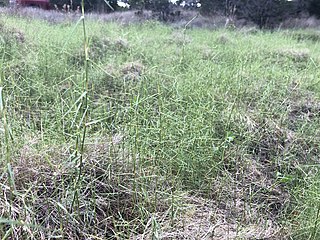
Muhlenbergia utilis is a species of grass known by the common name aparejograss.
The Window Cliffs State Natural Area covers 275 acres (111 ha) in Putnam County, Tennessee, near Cookeville. The Window Cliffs is the name of a prominent group of natural bridges in a narrow 200-foot-tall (61 m) ridge in the neck of a meander of Cane Creek. The day-use area is only accessible by hiking a 2.7 miles (4.3 km) trail. The Window Cliffs was an acclaimed destination in the nineteenth and early twentieth centuries. The area contains several state-listed endangered plants.
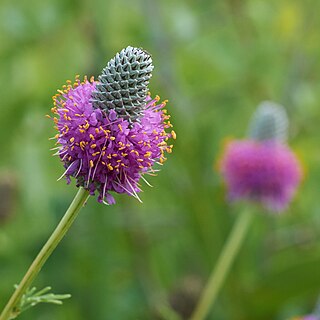
Dalea purpurea is a species of flowering plant in the legume family known as purple prairie clover. Native to central north America, purple prairie clover is a relatively common member of the Great Plains and prairie ecosystems. It blooms in the summer with dense spikes of bright purple flowers that attract many species of insects.

Liatris punctata is a species of flowering plant in the family Asteraceae known by the common names dotted gayfeather, dotted blazingstar, and narrow-leaved blazingstar. It is native to North America, where it occurs throughout the plains of central Canada, the central United States, and northern Mexico.
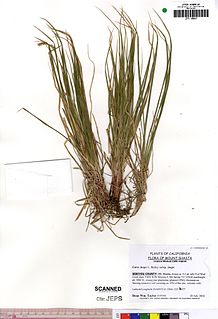
Carex inops is a species of sedge known as long-stolon sedge and western oak sedge. It is native to northern North America, where it occurs throughout the southern half of Canada and the western and central United States.
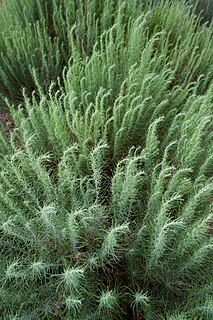
Artemisia filifolia, known by common names including sand sagebrush, sand sage and sandhill sage, is a species of flowering plant in the aster family. It is native to North America, where it occurs from Nevada east to South Dakota and from there south to Arizona, Chihuahua, and Texas.

Muhlenbergia glomerata is a species of grass known as spiked muhly and marsh muhly. It is native to North America, where it occurs across Canada and the northern half of the United States.
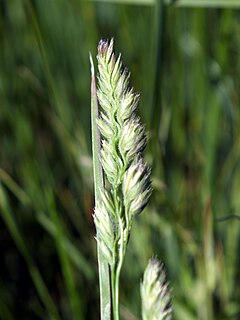
Muhlenbergia racemosa is a species of grass known by the common names green muhly and marsh muhly. It is native to North America, where it is most common in the north-central United States. It also occurs in the western United States and northern Mexico.

Poa arida is a species of grass known by the common names plains bluegrass and prairie speargrass. It is native to North America, where it occurs throughout western and central Canada and the central United States. It is most common east of the Continental Divide; specimens west are often misidentifications.
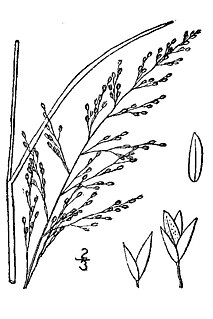
Muhlenbergia torreyana is a species of grass known by the common names New Jersey muhly, Torrey's muhly, and Torrey's dropseed. It is native to the eastern United States, where today it occurs in Maryland, New Jersey, North Carolina, and Tennessee. It has been extirpated from Delaware, Georgia, and New York.

Muhlenbergia capillaris, commonly known as the hairawn muhly, is a perennial sedge-like plant that grows to be about 30–90 cm (0.98–2.95 ft) tall and 60–90 cm (2.0–3.0 ft) wide. The plant includes a double layer; green, leaf-like structures surround the understory, and purple-pink flowers outgrow them from the bottom up. The plant is a warm-season grass, meaning that leaves begin growth in the summer. During the summer, the leaves stay green, but they morph during the fall to produce a more copper color. The seasonal changes also include the flowers, as they grow out during the fall and stay healthy till the end of autumn. The muhly grows along the border of roads and on plain prairies. The grass clumps into herds, causing bush-like establishments in the area the hairawn muhly inhabits. The flowers are very feathery and add a cloudlike appearance to the top of the grass. It is native to eastern North America and can be used for a multitude of purposes, including ornamental gardening and farming. It was voted 2012 plant of the year by the Garden Club of America.
The ecology of the Great Plains is diverse, largely owing to their great size. Differences in rainfall, elevation, and latitude create a variety of habitats including short grass, mixed grass, and tall-grass prairies, and riparian ecosystems.


















